Abstract
The murine genetic control of resistance to Pseudomonas aeruginosa eye infection previously has been demonstrated to be regulated by two complementing dominant genes, PsCR1 and PsCR2. The PsCR1 locus apparently is not associated with the H-2 complex, whereas the PsCR2 locus could not definitively be associated with H-2. In this study we attempted to demonstrate a possible H-2 linkage of the PsCR2 locus. A panel of inbred congenic strains varying with either the H-2 haplotype or genetic background from inbred partners of C57BL/10, C3H, A, and BALB/c strains were characterized for their P. aeruginosa infectivity phenotypes. These studies indicated that the PsCR2 locus is not associated with the H-2 locus. Furthermore, variations of the H-2 haplotype did not change the resistance patterns observed in these strains. However, BALB.B and BALB.K congenic lines were resistant to P. aeruginosa eye infection, whereas BALB/cJ mice were susceptible. Examination of hybrids (BALB.K X BALB/cJ)F1 and (BALB.B X BALB/cJ)F1 demonstrated that an autosomal dominant gene(s), PsCR, confers resistance. Segregation analysis for the H-2 haplotype and the PsCR gene in offspring of backcross matings with the BALB/cJ parental strain suggested that this PsCR gene is not linked to the H-2 complex and has an inheritance pattern of a single locus or several tightly linked loci.
Full text
PDF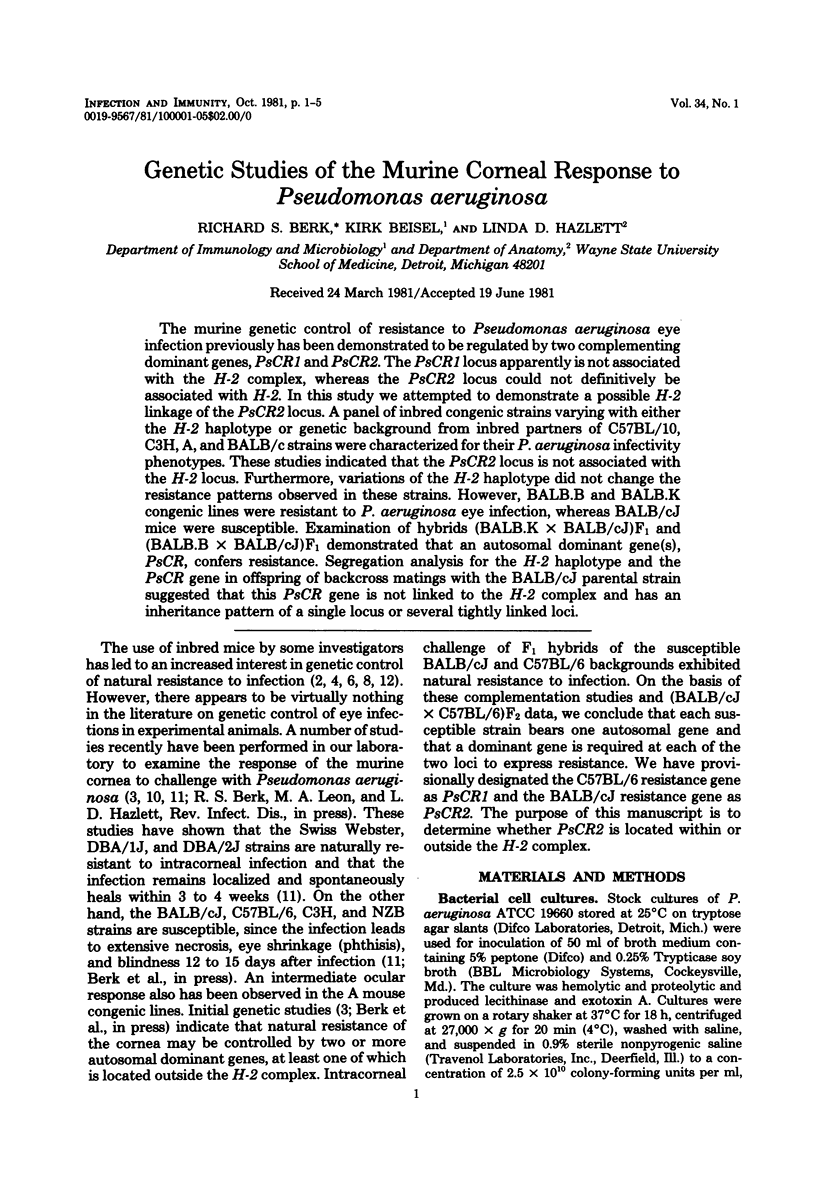
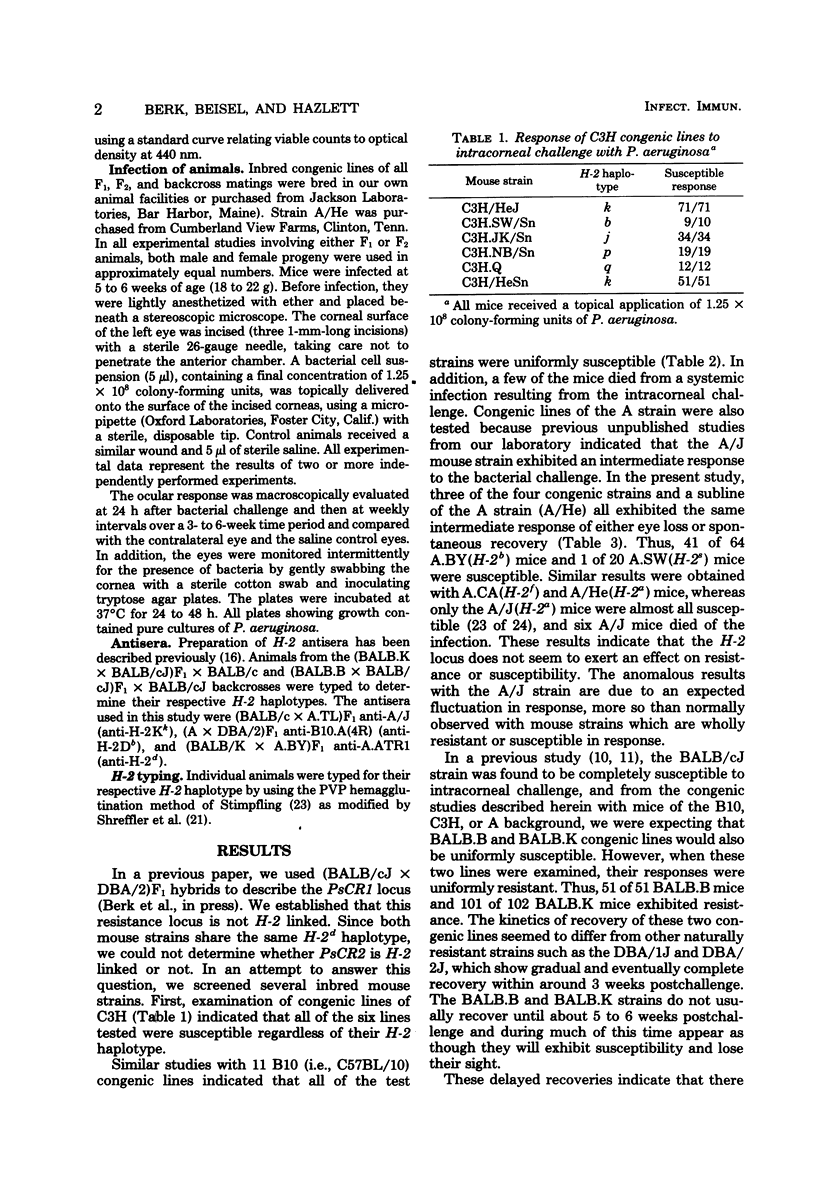
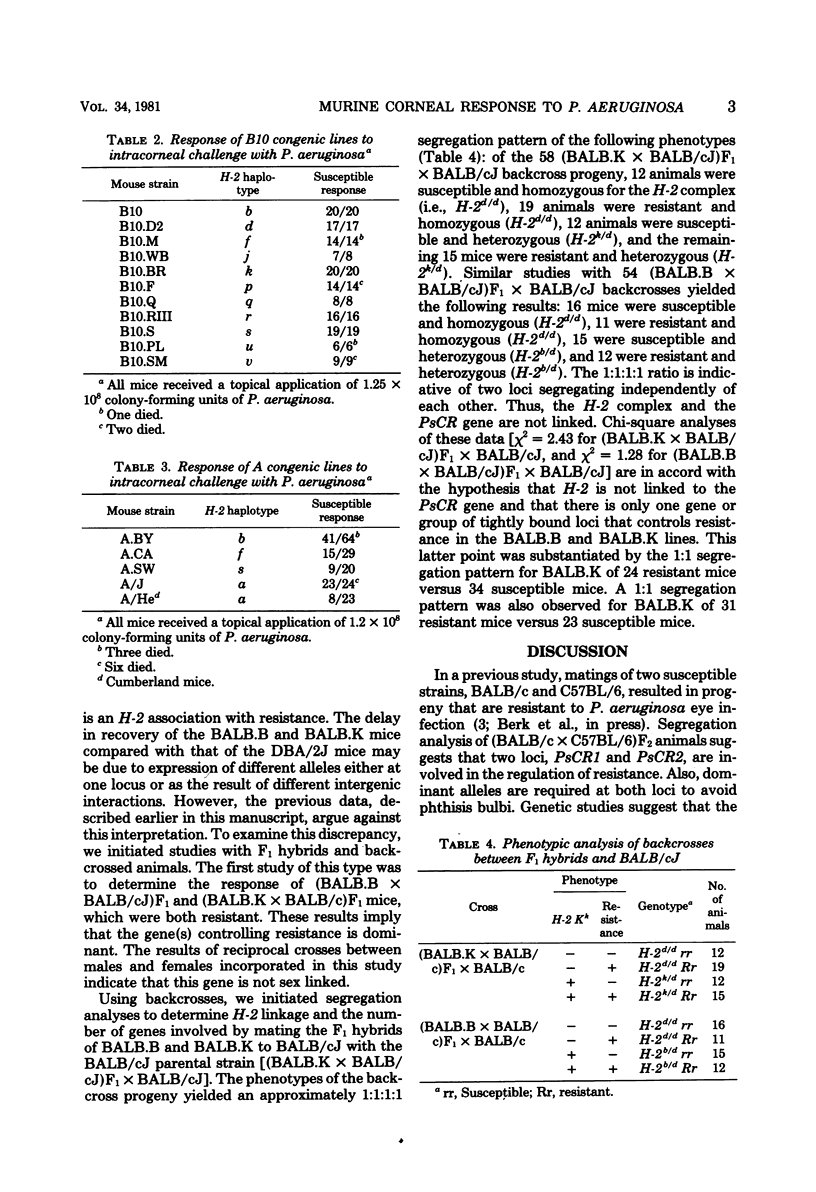
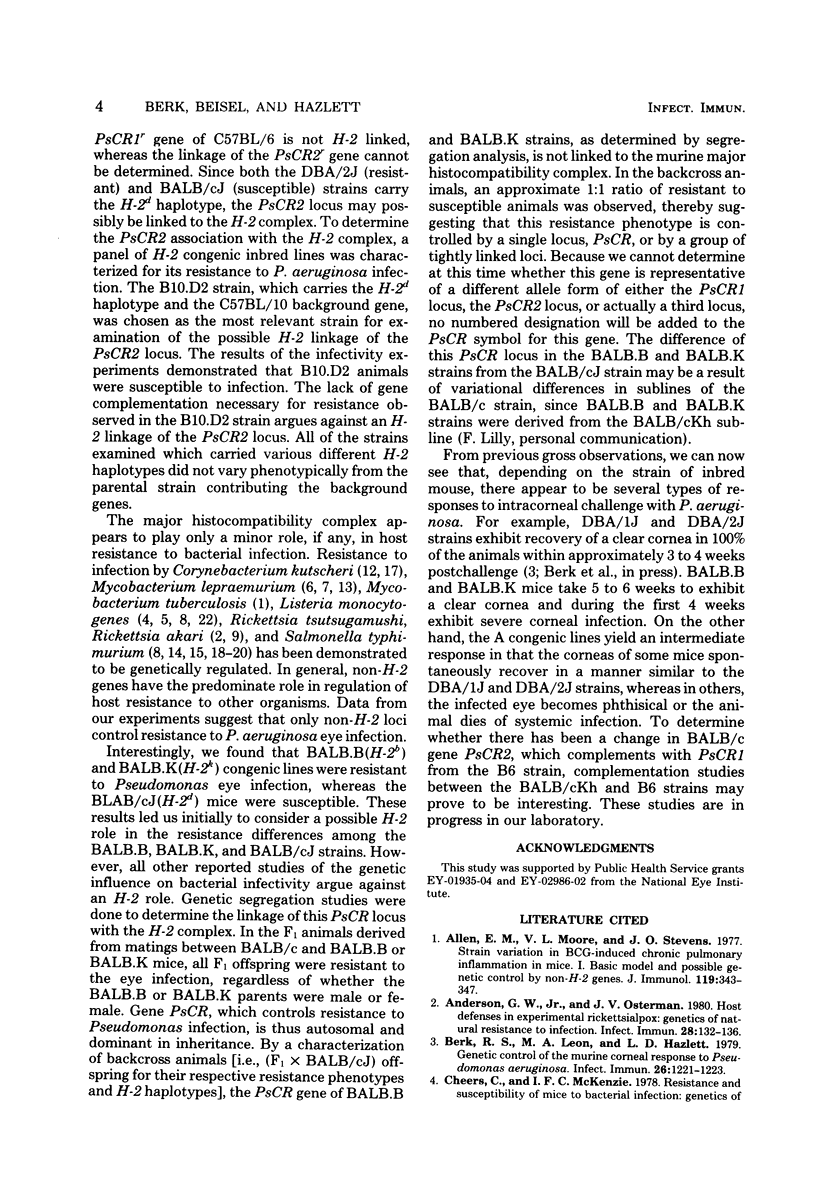
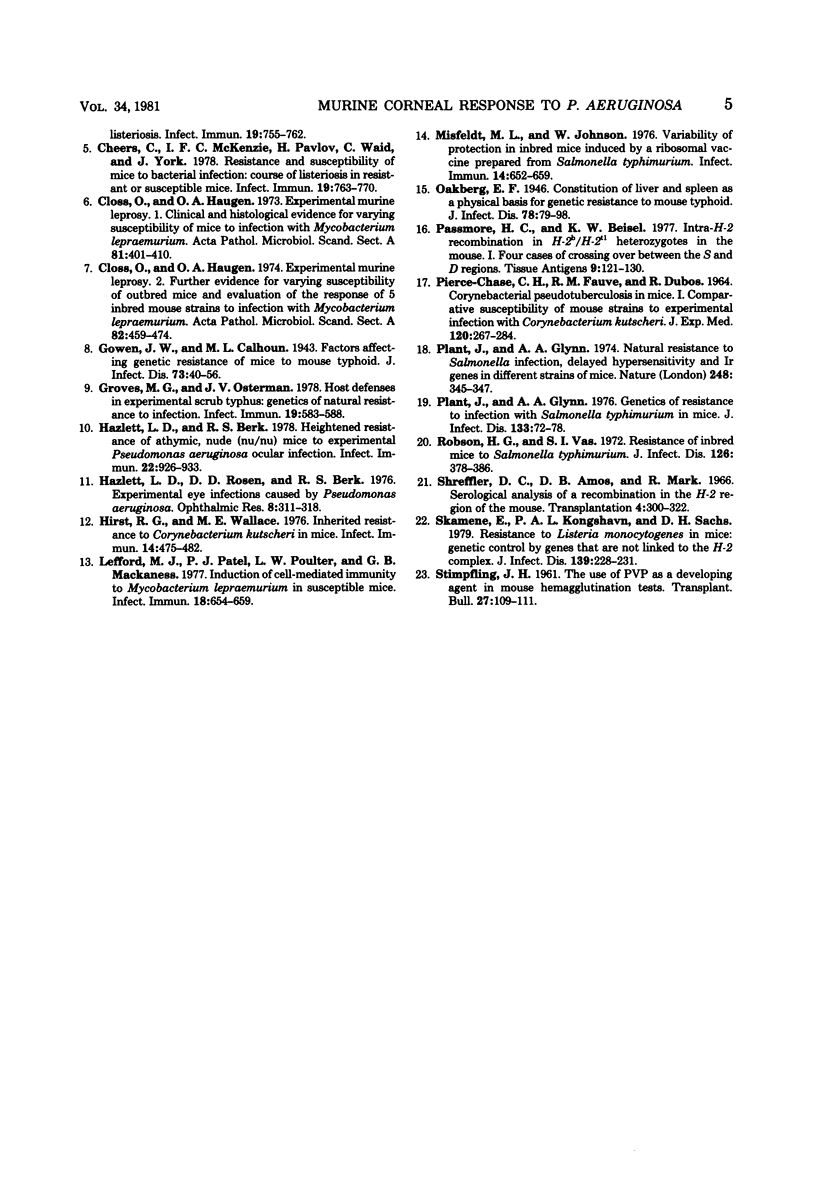
Selected References
These references are in PubMed. This may not be the complete list of references from this article.
- Allen E. M., Moore V. L., Stevens J. O. Strain variation in BCG-induced chronic pulmonary inflammation in mice. I. Basic model and possible genetic control by non-H-2 genes. J Immunol. 1977 Jul;119(1):343–347. [PubMed] [Google Scholar]
- Anderson G. W., Jr, Osterman J. V. Host defenses in experimental rickettsialpox: genetics of natural resistance to infection. Infect Immun. 1980 Apr;28(1):132–136. doi: 10.1128/iai.28.1.132-136.1980. [DOI] [PMC free article] [PubMed] [Google Scholar]
- Berk R. S., Leon M. A., Hazlett L. D. Genetic control of the murine corneal response to Pseudomonas aeruginosa. Infect Immun. 1979 Dec;26(3):1221–1223. doi: 10.1128/iai.26.3.1221-1223.1979. [DOI] [PMC free article] [PubMed] [Google Scholar]
- Cheers C., McKenzie I. F., Pavlov H., Waid C., York J. Resistance and susceptibility of mice to bacterial infection: course of listeriosis in resistant or susceptible mice. Infect Immun. 1978 Mar;19(3):763–770. doi: 10.1128/iai.19.3.763-770.1978. [DOI] [PMC free article] [PubMed] [Google Scholar]
- Cheers C., McKenzie I. F. Resistance and susceptibility of mice to bacterial infection: genetics of listeriosis. Infect Immun. 1978 Mar;19(3):755–762. doi: 10.1128/iai.19.3.755-762.1978. [DOI] [PMC free article] [PubMed] [Google Scholar]
- Closs O., Haugen O. A. Experimental murine leprosy. 2. Further evidence for varying susceptibility of outbred mice and evaluation of the response of 5 inbred mouse strains to infection with Mycobacterium lepraemurium. Acta Pathol Microbiol Scand A. 1974 Jul;82(4):459–474. [PubMed] [Google Scholar]
- Closs O., Haugen O. A. Experimental murine leprosy. I. Clinical histological evidence for varying susceptibility of mice to infection with Mycobacterium lepraemurium. Acta Pathol Microbiol Scand A. 1973 Jul;81(4):401–410. [PubMed] [Google Scholar]
- Groves M. G., Osterman J. V. Host defenses in experimental scrub typhus: genetics of natural resistance to infection. Infect Immun. 1978 Feb;19(2):583–588. doi: 10.1128/iai.19.2.583-588.1978. [DOI] [PMC free article] [PubMed] [Google Scholar]
- Hazlett L. D., Berk R. S. Heightened resistance of athymic, nude (nu/nu) mice to experimental Pseudomonas aeruginosa ocular infection. Infect Immun. 1978 Dec;22(3):926–933. doi: 10.1128/iai.22.3.926-933.1978. [DOI] [PMC free article] [PubMed] [Google Scholar]
- Hirst R. G., Wallace M. E. Inherited resistance to Corynebacterium kutscheri in mice. Infect Immun. 1976 Aug;14(2):475–482. doi: 10.1128/iai.14.2.475-482.1976. [DOI] [PMC free article] [PubMed] [Google Scholar]
- Lefford M. J., Patel P. J., Poulter L. W., Mackaness G. B. Induction of cell-mediated immunity to Mycobacterium lepraemurium in susceptible mice. Infect Immun. 1977 Dec;18(3):654–659. doi: 10.1128/iai.18.3.654-659.1977. [DOI] [PMC free article] [PubMed] [Google Scholar]
- Misfeldt M. L., Johnson W. Variability of protection in inbred mice induced by a ribosomal vaccine prepared from Salmonella typhimurium. Infect Immun. 1976 Sep;14(3):652–659. doi: 10.1128/iai.14.3.652-659.1976. [DOI] [PMC free article] [PubMed] [Google Scholar]
- PIERCE-CHASE C. H., FAUVE R. M., DUBOS R. CORYNEBACTERIAL PSEUDOTUBERCULOSIS IN MICE. I. COMPARATIVE SUSCEPTIBILITY OF MOUSE STRAINS TO EXPERIMENTAL INFECTION WITH CORYNEBACTERIUM KUTSCHERI. J Exp Med. 1964 Aug 1;120:267–281. doi: 10.1084/jem.120.2.267. [DOI] [PMC free article] [PubMed] [Google Scholar]
- Passmore H. C., Beisel K. W. Intra-H-2 recombination in H-2b/H-2t1 heterozygotes in the mouse I. Four cases of crossing over between the S And D regions. Tissue Antigens. 1977 Feb;9(2):121–130. doi: 10.1111/j.1399-0039.1977.tb01091.x. [DOI] [PubMed] [Google Scholar]
- Plant J., Glynn A. A. Genetics of resistance to infection with Salmonella typhimurium in mice. J Infect Dis. 1976 Jan;133(1):72–78. doi: 10.1093/infdis/133.1.72. [DOI] [PubMed] [Google Scholar]
- Plant J., Glynn A. A. Natural resistance to Salmonella infection, delayed hypersensitivity and Ir genes in different strains of mice. Nature. 1974 Mar 22;248(446):345–347. doi: 10.1038/248345a0. [DOI] [PubMed] [Google Scholar]
- Robson H. G., Vas S. I. Resistance of inbred mice to Salmonella typhimurium. J Infect Dis. 1972 Oct;126(4):378–386. doi: 10.1093/infdis/126.4.378. [DOI] [PubMed] [Google Scholar]
- Shreffler D. C., Amos D. B., Mark R. Serological analysis of a recombination in the H-2 region of the mouse. Transplantation. 1966 May;4(3):300–322. doi: 10.1097/00007890-196605000-00008. [DOI] [PubMed] [Google Scholar]
- Skamene E., Kongshavn P. A., Sachs D. H. Resistance to Listeria monocytogenes in mice: genetic control by genes that are not linked to the H-2 complex. J Infect Dis. 1979 Feb;139(2):228–231. doi: 10.1093/infdis/139.2.228. [DOI] [PubMed] [Google Scholar]


